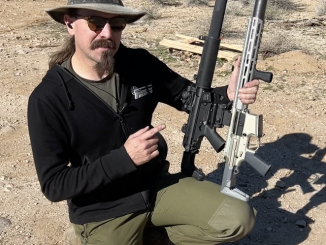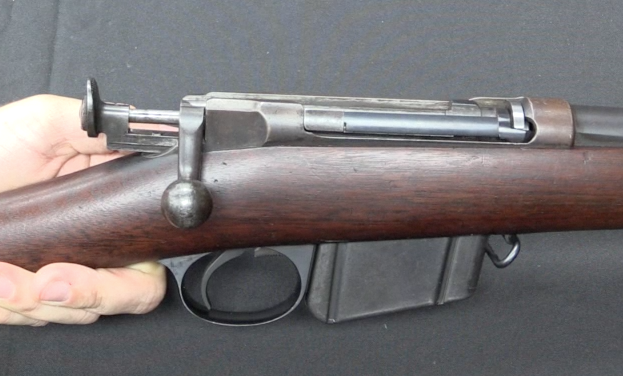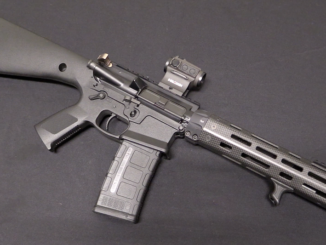The South Korean military was using old Colt M1911A1 pistols in the 1980s, and as they became worn out a new pistol was needed. This would be something designed and built domestically, and chambered for 9×19. The small arms division of the massive Daewoo industrial conglomerate, called Daewoo Precision Industries, spent several years in the mid 80s designing what would be adopted in 1990 as the K5 pistol. It took elements from the Beretta 92 and 3rd-generation S&W automatics, and the “fast action” trigger mechanism from FN and combined them into a compact, reliable duty pistol.
The “fast action” trigger, also called “triple action” or “double action plus” is a DA/SA trigger in which the hammer can be manually pushed forward after being cocked. This gives the system a hybrid trigger pull, with the weight of single action but the length of double – theoretically ideal for carry.
Daewoo imported K5 pistols to the US until 1997 through several different importers under the designation DP-51 (and also the DP-51C compact and the DP-40 in .40 S&W). By the late 90s Daewoo was in financial trouble, and the small arms division was eventually spun off into a separate company, called S&T Motiv. They began importing the K5 again circa 2012, not designated the LH9, through US company Lionheart Industries. Lionheart moved form importing the guns to manufacturing them in Washington in 2016, renaming them the Regulus and adding better sights, slide serrations, frame texture, and other commercial options. Lionheart was subsequently sold to a new US owner and its manufacturing moved to Georgia, where it was again renamed as the Vulcan 9 and released in 2023.
The Vulcan-9 remains mechanically the same as the original K5, but offers a variety of modern options, including threaded extended barrels and optics cuts. It’s still a relatively compact pistol, but one that is now pretty well loaded with features (albeit for a quite high price).
Thanks to Lionheart for loaning me the three iterations of their company’s pistols for this video!




I’ve been a fan of Lionheart since I met them at the 2022 NRAAM. I have two Regulus pistols that I shoot regularly, and I’ve been waiting for a Vulcan for a few months now. Good stuff!
Which pistols predates the Daewoo’s triple action?
I think the Hi-Power’s Safe Fast Shooting, Para Ordnance’s Light Double Action, and the HK’s LEM are similar mechanisms with coaxial internal and external hammers (but not exactly the same).
When I first saw these, the very first thing that popped into my mind was “WTF?”
I can see why Beretta went with the external drawbar with the transition from the Brigadier M1951 to the M92 series, but… Why, for the love of God and all things holy, would you do that on a new, clean-sheet design? I mean, how hard would it be to look at the S&W M59 or the CZ-75, and keep everything nicely internal and forego all the potential points of ingress for mud and dirt? Not to mention, the issues with that damn drawbar getting nice and corroded/filthed into non-functionality?
At the time, and still, I dismissed the K5 and its derivatives as a poor attempt by people that don’t know anything about handguns. I wouldn’t be surprised to hear that they’d started out with a Colt M1911A1 and an Armand Swenson conversion as a starting point.
Spend enough time in arm’s rooms around the M9, and you’ll learn a certain contempt for that drawbar; the idea is vaguely acceptable in a conversion, totally inappropriate in something you’re designing from new. It’s a “conversion feature”, much like a trap-door breechloader: You only do that when you have no other choice.
Would we have been better off with an upgraded form of the FN GP35?
What you stated is the reason I’ve always found the external drawbar on the Walther P.38 inexplicable.
The Walther PP and PPK have the drawbar neatly tucked away in a channel in the frame, a feature apparently “borrowed” from the earlier Menz DA/SA pocket automatic.
(It’s just a pity they didn’t also “borrow” the Menz’ more sensible hammer block safety.)
The Beretta M92 apparently has the external drawbar because “Well, the Walther P.38 has it that way, and everybody knows Walther’s make The Best Pistols In The World and they’re our main competitor, so that’s obviously The Way To Do It”.
(“And anyway, we’ve already ripped off their locking system in the M1951….”)
In short, I don’t think there was a Hell of a lot of “thought” given to much of anything in the Beretta M92 design. Even the magazine started life as two P35 High Power 13-round boxes cut apart at two different points, and the “long” halves TIG-welded together to create a 15-round box. (Why? Because the S&W M59 had a 15-rounder, that’s why.)
BTW, John M. Browning had a P.38 type drawbar for double-action on the one-off original GP prototype for the French Army in 7.65 x 20mm, but left it off all subsequent High Power prototypes because it added mechanical complication to an already less-than-straightforward searage (compared to the 1911’s).
I think it says a lot that today, only a couple of companies make P35 “clones”, while the big thing seems to be 1911s in 9 x 19mm with double-column 15-shot magazines. Making the “stirrup” that goes around the magazine well wider (a trick Para-Ordnance and Caspian came up with almost forty years ago) seems to be the only major alteration to the basic 1911 design to achieve this.
Now if they just made them in 9 x 25mm Mauser…..
clear ether
eon
I think it says a lot about the proficiency of a designer or design team when they start doing stuff like copying that drawbar…
I mean, it isn’t like the issues aren’t well-documented, now is it?
You’re doing a clean-sheet design? Do it from first principles, and don’t just copy-paste from one set of blueprints to another. I don’t think any mechanism ought to have actuating pieces out in the open where you can screw with them…
In the course of things, I had one M9 in my career that went away to the shredder because the guy who had it on his gear got whacked with something during a training accident. We never quite figured out what it was, but if you picture something like a baseball bat hitting someone with enough force to break a couple of ribs (tanker’s holster, cross-draw), and also impacting the pistol hard enough to damage that drawbar…? Yeah. Myself, I think he hit the edge of the hatch when the track rolled, but he insisted he’d gotten down below that height when it got that far, and since he wasn’t crushed, I have to guess it was something else…
In any event, whatever it was screwed that pistol up something weird… You could still operate the slide, you didn’t see the damage, really, but when you tried to pull the trigger? Nope; same when you tore it down: You couldn’t get that drawbar to budge a bit, because whatever whacked it didn’t do any obvious cosmetic damage, but it did something such that the bar wasn’t coming out, and when I turned it in to Third Shop, they coded it out. Completely.
Might have happened similarly to an M59 or something, but I rather doubt it.
I’m sorry, Mr. Kojiru Nambu: Key operating bits do not belong on exposed surfaces…
The Type 94 did set sort of a record for unusable impracticality.
Bad searage design? Check.
Badly un-ergonomic grip design? Check.
Inadequate magazine design (too small capacity, jams routinely)? Check.
Recoil spring insufficiently protected from environment? Check.
Let’s not get into the problems with 8 x 22mm cartridge design and concept. It couldn’t do anything from a locked-breech platform that a 9 x 20SRmm Browning, or for that matter a .380 ACP couldn’t do from a blowback.
The smart thing to do would have been to up-caliber the Type 14 to 9 x 19mm and give it a double-column magazine. But doing “the smart thing” was never IJA Ordnance’s thing any more than it was ours.
I suppose that’s sort of an excuse for Nambu Kijiro. But there’s really no excuse for Walther or Beretta.
Once again, the more I see of “service automatics”, the more I think that double-action revolvers are still pretty hard to beat. The only real exception being anything designed by J. M. Browning.
cheers
eon
The sheer ego involved, the arrogance, the delusion…
I think Browning pretty much hit it out of the park with the basic action and everything else; there’s really no reason to do anything different, especially if you’re in a hurry to build a practical weapon in short order. So, why the hell not copy any one of the many working Browning designs, other than sheer hubris and/or pride?
Inexplicable. Personally, my take on a lot of these utter stupidities on the part of design and procurement types is that they’ve fundamentally failed in their one pure mission: Get working weapons into the hands of the troops. Can’t do that? Won’t do that? The samurai penalty for substandard smith work on swords springs to mind… Find the smith, insert broken bits of blades up fundament.
Y’all really do not want to know what I’ve idly thought up, over the long hours of trying to make the M60 work as a company-level support weapon…
“(…)problems with 8 x 22mm cartridge design and concept. It couldn’t do anything from a locked-breech platform that a 9 x 20SRmm Browning, or for that matter a .380 ACP couldn’t do from a blowback.(…)”
They finally managed to craft blow-back automatic pistol for said cartridge known as HAMADA TYPE 2 https://www.forgottenweapons.com/other-handguns/japanese-hamada/ which was lazily adopted because of tension between military ordnance officers and the notably non-military lineage of Hamada and his pistol
The excuse for Beretta is that they were adapting the m1951 to double action and staggered magazine, and they did because the M1951 worked and gained a solid reputaton.
The drawbar couldn’t pass any more on the side of the magazine, it had to pass over it, but there was the frame there.
Cut a guide in the frame?
The M1951 started production with an alloy frame, then they had to revert to steel, because the alloy wasn’t strong enough. Only near to the end of production they found the right alloy and manufacturing process, and made them alloy framed again.
Imagine messing it by cuttig channels in the frame.
Today it can seem ridiculous, but at that time “if it ain’t broke, don’t fix it”. Today is not 1976, nor 1986. Design is made differently.
Worth it? In the XM9 program, only two manufacturers had all three guns tested for endurance reach the 7000 rounds threshold without breaking a frame. Beretta and HK.
It was possible with an internal drawbar? Obvious. Maybe studying the problem and testing prototypes for one or two years more. How many contracts do you lose in the meantine?
The P38 has an external drawbar because the place in the frame it occupied in the PPK had been taken by one of the recoil springs.
“(…)DP-51(…)Regulus(…)Vulcan(…)”
So they first use letters-digits designation, then name of atomic-warhead-delivery ship-launched system (SSM-N-8) to finally switch to name of one of V-bombers. Was that explained by their marketing campaigns or this meander of U.S. fire-arm marketing should remain beyond comprehension?
“DP-51” probably started out as an anagram of “P-51D”.
“Regulus” most likely was meant to refer to the star, not the missile.
And “Vulcan” is an American “comfort word”, thanks to Star Trek.
In short, you’re most likely seeing the results of “studies” done by Madison Avenue “marketing experts”, who charge manufacturers enormous fees to tell them what they should name their products for the best “consumer response”. (I.e., getting people to actually buy their products.)
If you watch the TV series Mad Men, about Madison Avenue in the early 1960s, you quickly realize the entire menage’ is a nearly perfect combination of Parkinson’s Laws and the Dilbert Principle.
clear ether
eon
I was told that it was a factory product number… Supposedly. Happened sorta like the way the Datsun 240Z went from “Fairlady Z” in Japan to “240Z” here in the US…
Apparently, the “240” part referred to the displacement of its 6-cylinder engine; 240 CC or 2.4 liters (146 CI in other words). At 151 HP it actually achieved the Holy Grail of Automotive Engine Design; 1 HP or better per CI. It practically became the Japanese auto industry’s answer to the E-Type Jaguar six-cylinder variant.
The later Nissan 280Z, by comparison, was intended more to appeal to yuppies who thought RPM meant “Really Permanent Mousse”.
cheers
eon
There’s a rare Japan-only version with a twin-cam 2-liter engine. I finally got to see one on YouTube. Since it was the Fairlady there, not the 240Z, they didn’t have to change the designation.
I think you are right in your assumption that 240 refers to 2.4 liters. Mercedes did the same: for example, a 190SL had 1.9 liters, a 300SL 3.0 liters etc.
But actually, 2.4 liters are 2400 CC, as used by BMW 1600 or Volkswagen 1500.
It’s “Wine-der”.
In Georgia, a “win-der” is something you look out of.
Washington the city or Washington the state